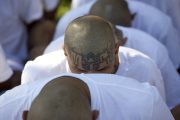
The Intercept has published a 166-page manual of how the federal government puts people on the “no-fly list” and monitors American citizens. Obtained from whistleblower Edward Snowden, the information on the Glenn Greenwald-founded website revealed that the Obama administration has lowered the legal threshold for warrantless government surveillance of American citizens.
The federal manual explains the standard of evidence for spying on Americans:
Nominations of U.S. PERSONS shall be made based on information from sources of known reliability or where there exists additional corroboration or context supporting REASONABLE SUSPICION. [Emphasis in original.]
Note that the constitutional standard of “probable cause” does not occur within the context of the evidence standard for adding an American to a no-fly list or targeting that person for surveillance. Also lacking are the Fourth Amendment requirements for a court warrant with a description of what the government is looking for and where they expect to find it.
The mandate for surveillance of Americans by intelligence agencies continues: “Each NOMINATING AGENCY will seek to obtain as much DEROGATORY INFORMATION and identifying information as practicable.” (Emphasis in original.) Details include biometric information such as photos, DNA, retina scans, fingerprints, and the like, as well as ordinary identifiers such as e-mail addresses, phone numbers, etc.
Even remarks on social media can get someone listed on the watch list and constitute the necessary “reasonable suspicion” for surveillance, according to the manual. “Single source information, including but not limited to ‘walk-in,’ ‘write-in,’ or postings on social media sites, however, should not automatically be discounted merely because of the manner in which it was received.”
But even the weak and unconstitutional standard of “reasonable suspicion” for surveillance of Americans can be waived under Obama’s rules, which stipulate that some cases don’t need even “reasonable suspicion” — specifically involving “Individuals Identified Pursuant to Statute or Executive Order.” In other words, if the president or another high-ranking federal official doesn’t like you, they can surveil you without a warrant or any evidence whatsoever.
Obama issued a secret executive order January 7, 2010 which caused a review that changed the rules of the game, according to Intercept writers Jeremy Scahill and Ryan Devereaux. They advise that the “minimum substantive derogatory criteria guidance has been restructured to elaborate on instances of where particularized derogatory information is required to meet the reasonable suspicion standard, and when reasonable suspicion is established by other authority.”
The “other authority” in question is either the president or a senior political appointee.
The watch list includes not just terrorists, but also those who engage in “activities that facilitate or support TERRORISM and/or TERRORIST ACTIVITIES such as providing a safe house, transportation, communications, funds, transfer of funds or other material benefit,” and other things. (Emphasis in original.) This includes people who are not wittingly helping terrorists. The manual states that it is permissible to surveil non-terrorists — usually family members and friends of people who are on the watch list.
The news of warrantless surveillance of Americans with lower than constitutional thresholds for evidence has drawn criticism from the head of the ACLU’s National Security Project, Hina Shamsi, who told The Intercept on July 25:
Instead of a watchlist limited to actual, known terrorists, the government has built a vast system based on the unproven and flawed premise that it can predict if a person will commit a terrorist act in the future. On that dangerous theory, the government is secretly blacklisting people as suspected terrorists and giving them the impossible task of proving themselves innocent of a threat they haven’t carried out.
Also, Scahill and Devereaux note that broad surveillance waged against Americans may actually be making the American people less secure. The authors explain that this type of surveillance “can also be counterproductive. When resources are devoted to tracking people who are not genuine risks to national security, the actual threats get fewer resources — and might go unnoticed.”




